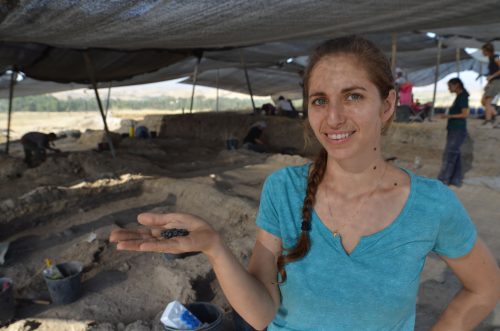*Until now, archaeologists have not found evidence of irrigation systems in such an early period and it is estimated that at this stage of human development this ability did not exist. The hundreds of olive skins found in the excavations at Tel-Zaf in the Beit Shai Valley, led by researchers from the University of Haifa and the Archaeological Institute in Berlin, require a rethinking of this assumption*

They ate wheat, barley and buckwheat, lentils and peas. They had herds of goats, sheep, cattle and also pigs, which they ate mainly on occasions of particularly festive events. And now, during the last excavation season, the researchers discovered hundreds of olive kernels, which requires a rethink - about ancient irrigation methods or ancient trade. Researchers from the Zinman Institute at the University of Haifa in combination with researchers from other universities in the world reveal the lifestyle of our ancestors who lived over 7,000 years ago in Tel Tsef in the Beit Shan Valley. "The existence of such an ancient agricultural system that relies on artificial irrigation will require a significant change in the way we perceive their agricultural sophistication," said Prof. Danny Rosenberg from the Zinman Institute of Archeology at the University of Haifa, who is managing the research project at Tel Tsef together with Dr. Florian Klimsche from the Institute The German Institute for Archeology in Berlin (DAI).
Tel Tsef is a prehistoric site located on the border with Jordan, not far from Kibbutz Tirat Zvi. The site is over 7000 years old, a time when humans already lived in permanent settlements and relied on an economy of plants and domesticated animals, but before the appearance of the ancient cities that were characterized by a complex socio-economic organization. This period actually forms the basis for the establishment of the ancient cities and ancient cultures of the ancient Middle East - which are considered the cradle of civilization, but so far it has hardly been studied in our region.
The new research, led by Prof. Rosenberg and Dr. Klimsha and combining researchers from a wide range of disciplines, focuses, among other things, on the botanical find that is evidence of the environmental conditions that prevailed in the Jordan Valley about 7000 years ago, the economic planning and diet of the ancient population in the region, their agricultural methods and their complex social organization . As mentioned, the main discovery of the last excavation season that just ended was hundreds of olive pits. Intensive exploitation of olives during this period is already known, but the large amount found in Tel Tsef, together with the fact that most of the pits were found in certain areas only, raises several questions and requires, according to Prof. Rosenberg, a rethinking of the ancient irrigation methods or, alternatively, of the ancient trade relations In olives and maybe even in olive oil.
"The Jordan Valley is not a natural environment for olive trees throughout history, and even today olive trees are grown in this area through artificial irrigation. The reliable archaeological evidence we have today supports artificial irrigation only in a later period, so the existence of such an ancient agricultural system relying on artificial irrigation would require a significant change in the way we perceive their agricultural sophistication. Another thing that is connected to this issue is the evidence of plowing that comes from a study done on the cattle bones found in Tel Tsaf, evidence that found pathologies in the leg bones of cattle, and which indicate a great effort," said Prof. Rosenberg.
From the many evidences of the botanical material found in Tel Tsef in the last four years, the researchers succeed in reconstructing the economy of existence of the ancient inhabitants of the Jordan Valley. The researchers found that the plant species that were grown were those that allow each other to "back up" in terms of ripening time that occurs in different seasons, taking into account the possibility of "weak" years and of course species that are nutritional supplements that combine carbohydrates, proteins, vitamins and more. For example, the ripening time of the wheat and barley is different from that of the olive and the lentils and peas found on the site, and each of the different species also has a different nutritional contribution. Thousands of animal bones testify to the cultivation of herds of goats, sheep, pigs and various types of cattle.
"We hope that by combining the local council and the relevant government ministries, we will be able to continue the important research in the coming years and formulate a conservation and accessibility plan for this rare site, because it provides a rare glimpse into the lifestyles of the ancient inhabitants of the Jordan Valley and the heritage of the region in general, and allows a visit not only to their homes but also to the plates and pots theirs", Prof. Rosenberg concluded.

5 תגובות
unlikely. This is not Siberia. In Siberia, a mammoth was found with blood dripping from it, a complete body and fur.
I wonder if there is really an essence of genetic material left. So it can be transplanted into a new olive kernel and possibly delete the new information.
The question is whether it is possible to germinate these olive seeds, and grow an olive tree of the variety that existed 9000 years ago. As I recall, the seed of a date tree from Masada excavations from 2000 years ago was successful.
"In Emek Beit Shai" - should be corrected.